A Study on Welding Deformation in Fiber Laser Welding of 9% Nickel Steel through Finite Element Analysis Part I: Implementation of Welding Heat Source Model
Abstract
1. Introduction
2. Simulation Using Experimental and Finite Element Analysis Models
2.1. Welding Test Equipment and Test Conditions
2.2. Weld Bead Analysis
2.3. Finite Element Analysis Software
2.4. Material Properties by Temperature
2.5. Welding Heat Source Model
2.6. Research Process
2.7. Boundary Conditions of Heat Transfer Analysis
2.8. Optimization Algorithm
3. Results
3.1. Welding Test Results
3.2. Results of Welding Heat Source Model Search
4. Discussion
5. Conclusions
- The temperature distribution was checked through the heat transfer analysis using a moving heat source by simulating the fiber laser welding experiment of STS304L.
- Heat transfer analysis was performed using the heat source radius and the ratio of heat energy for each layer as variables and the pass or failure of a heat source was determined by comparing it to the experimental results. By changing the variables in conjunction with the optimization algorithm, a heat source model with pass condition was found in a short period of time.
- Each analysis was performed with different welding speeds and it was found that the welding heat source at 1.5 m/min, and 2.0 m/min under 4 kw condition was similar to the conical-conical combination model.
- From the analysis according to the welding speed, it is found that welding speed and the heat depth are inversely related. In addition, the energy ratio was different for each layer of a heat source and the concentration of the upper part of a heat source was higher as the speed is lower.
- In future research, the relationship between the welding conditions and the heat source model will be checked by comparing the heat source model under the welding conditions with different welding power and welding speed, and ultimately, a study will be performed to find a general heat source model for fiber laser welding.
Author Contributions
Funding
Institutional Review Board Statement
Informed Consent Statement
Data Availability Statement
Conflicts of Interest
References
- Kim, J.; Kim, J. The Characteristics of Continuous Waveshape Control for the Suppression of Defects in the Fiber Laser Welding of Pure Titanium Sheet (I). J. Weld. Join. 2016, 36, 62–68. [Google Scholar]
- Kim, J.; Kim, J.; Pyo, C. A Study on Fiber Laser Welding of High-Manganese Steel for Cryogenic Tanks. Processes 2020, 8, 1536. [Google Scholar] [CrossRef]
- Kim, D.S.; Pyo, C.; Kim, J.; Kim, J.; Lee, H.K. A Study on Cross-Shaped Structure of Invar Material Using Cold Wire Laser Fillet Welding (PART I: Feasibility Study for Weldability). Metals 2020, 10, 1385. [Google Scholar] [CrossRef]
- Na, K.; Lee, C.; Park, J.; Cho, M. A Comparison of Hot Cracking in GTAW and FCAW by Applying Alloy 625 Filler Materials of 9% Ni Steel. J. Weld. Join. 2019, 37, 357–362. [Google Scholar] [CrossRef]
- Kim, B.; Park, J.; Lee, J.; Kim, M. Study on the Initial Design of an LNG Fuel Tank using 9 wt.% Nickel Steel for Ships and Performance Evaluation of the Welded Joint. J. Weld. Join. 2019, 37, 555–563. [Google Scholar] [CrossRef]
- Yun, T.; Oh, W.; Lee, B.; Lee, C.; Na, H.; Choi, J.; Kim, I. A Study on Optimization of Fillet in Laser Welding Process for 9% Ni Steel Using Gradient-Based Optimization Algorithm. J. Weld. Join. 2020, 38, 485–492. [Google Scholar] [CrossRef]
- Kim, J.; Kim, J.; Kang, S.; Chun, K. Laser Welding of ASTM A553-1 (9% Nickel Steel) (PART I: Penetration Shape by Bead on Plate). Metals 2020, 10, 484. [Google Scholar] [CrossRef]
- Kim, J.; Kim, J. Laser Welding of ASTM A553-1 (9% Nickel Steel) (PART II: Comparison of Mechanical Properties with FCAW). Metals 2020, 10, 999. [Google Scholar] [CrossRef]
- Huang, Z.; Cai, Y.; Mu, W.; Li, Y.; Hua, X. Effects of laser energy allocation on weld formation of 9%Ni steel made by narrow gap laser welding filled with nickel based alloy. J. Laser Appl. 2018, 30, 032013. [Google Scholar] [CrossRef]
- Trinh, L.N.; Lee, D. Welding of Thin Tab and Battery Case for Lithium-ion Battery Cylindrical Cell Using Nanosecond Pulsed Fiber Laser. J. Weld. Join. 2020, 38, 389–394. [Google Scholar] [CrossRef]
- Choi, K.; Lee, J.; Hong, J.; Chung, W. A Study on the Variation of Physical Properties of Line-heated for Type-B LNG Fuel Tank with 9% Nickel Steel Plate. J. Korean Soc. Manuf. Process. Eng. 2020, 19, 89–97. [Google Scholar] [CrossRef]
- Park, J.; Kim, Y.; Baek, H.; Cho, S. A study on process development of super-TIG welding for 9% nickel steel with Alloy 625. J. Manuf. Process. 2019, 40, 140–148. [Google Scholar] [CrossRef]
- Pyo, C. A Study for Heat Source Model for Fiber Laser Welding with Global Optimization Algorithm Part I. Verification of Multi Layered Heat Source Model. J. Korean Soc. Mech. Technol. 2021, 23, 137–144. [Google Scholar]
- Pyo, C. A Study for Heat Source Model for Fiber Laser Welding with Global Optimization Algorithm Part II. Comparison of Optimization Algorithms. J. Korean Soc. Mech. Technol. 2021, 23, 226–233. [Google Scholar]
- Pyo, C. A Study for Heat Source Model for Fiber Laser Welding with Global Optimization Algorithm Part III. Analysis of the parameters with welding power. J. Korean Soc. Mech. Technol. 2021, 23, 492–498. [Google Scholar]
- Goldak, J.; Chakravarti, A.; Bibby, M. A new finite element model for welding heat sources. MTB 1984, 15, 299–305. [Google Scholar] [CrossRef]
- Chujutalli, J.; Lourenço, M.; Estefen, S. Experimental-based methodology for the double ellipsoidal heat source parameters in welding simulations. Mar. Syst. Ocean Technol. 2020, 15, 110–123. [Google Scholar] [CrossRef]
- Gao, Z.; Jiang, P.; Mi, G.; Cao, L.; Liu, W. Investigation on the weld bead profile transformation with the keyhole and molten pool dynamic behavior simulation in high power laser welding. Int. J. Heat Mass Transf. 2018, 116, 1304–1313. [Google Scholar] [CrossRef]
- Dal, M.; Fabbro, R. [INVITED] An overview of the state of art in laser welding simulation. Opt. Laser Technol. 2016, 78, 2–14. [Google Scholar] [CrossRef]
- Kim, J.; Jang, B.; Kim, Y.; Chun, K. A study on an efficient prediction of welding deformation for T-joint laser welding of sandwich panel PART I: Proposal of a heat source model. Int. J. Naval Arch. Ocean 2013, 5, 348–363. [Google Scholar] [CrossRef]
- Farrokhi, F.; Endelt, B.; Kristansen, M. A numerical model for full and partial penetration hybrid laser welding of thick-section steels. Opt. Laser Technol. 2019, 111, 671–686. [Google Scholar] [CrossRef]
- Xu, G.; Wu, C.; Qin, G.; Wang, X.; Lin, S. Adaptive volumetric heat source models for laser beam and laser + pulsed GMAW hybrid welding processes. Int. J. Adv. Manuf. Technol. 2011, 57, 245–255. [Google Scholar] [CrossRef]
- Evdokimov, A.; Springer, K.; Doynov, N. Heat source model for laser beam welding of steel-aluminum lap joints. Int. J. Adv. Manuf. Technol. 2017, 93, 709–716. [Google Scholar] [CrossRef]
- Kik, T. Heat Source Models in Numerical Simulations of Laser Welding. Materials 2020, 13, 2653. [Google Scholar] [CrossRef]
- Kim, K.; Nam, K.; Lee, J.; Seo, J.; Cho, H. Finite element analysis for prediction of bead shape of Nd:YAG laser butt welding. J. Korean Soc. Mar. Eng. 2008, 32, 137–246. [Google Scholar]
- Rahman, J.; Vasudevan, C.; Muthukumaran, S.; Ravi, R.; Chandrasekhar, K. Simulation of laser butt welding of AISI 316L stainless steel sheet using various heat sources and experimental validation. J. Mater. Process. Technol. 2015, 219, 48–59. [Google Scholar] [CrossRef]
- Rong, Y.; Mi, G.; Xu, J.; Huang, Y.; Wang, C. Laser penetration welding of ship steel EH36: A new heat source and application to predict residual stress considering martensite phase transformation. Mar. Struct. 2018, 61, 256–267. [Google Scholar] [CrossRef]
- Unni, K.; Vasudevan, M. Determination of heat source model for simulating full penetration laser welding of 316 LN stainless steel by computational fluid dynamics. Mater. Today Proc. 2021, 45, 4465–4471. [Google Scholar] [CrossRef]
- Artinov, A.; Bachmann, N.; Rethmeier, M. Equivalent heat source approach in a 3D transient heat transfer simulation of full-penetration high power laser beam welding of thick metal plates. Int. J. Heat Mass Transf. 2018, 122, 1003–1013. [Google Scholar] [CrossRef]
- Agarwal, G.; Gao, H. Murugaiyan Amirthalingam, Marcel Hermans, Study of Solidification Cracking Susceptibility during Laser Welding in an Advanced High Strength Automotive Steel. Metals 2018, 8, 673. [Google Scholar] [CrossRef]
- Yang, H. A Study on Heat Flow of Laser-Welded Dissimilar Steel Joints with Gap. J. KIMST 2007, 10, 5–15. [Google Scholar]
- Lee, K.; Yun, G. A Finite Element Model of Melt Pool for the Evaluation of Selective Laser Melting Process Parameters. J. KIMST 2020, 23, 195–203. [Google Scholar] [CrossRef]
- Ruolin, Z.; Xin, T.; Lidong, X.; Fenggui, L. Study of molten pool dynamics and porosity formation mechanism in full penetration fiber laser welding of Al-alloy. Int. J. Heat Mass Transf. 2020, 148, 119089. [Google Scholar]
- Zhou, Q.; Wang, Y.; Choi, S.; Cao, L.; Gao, Z. Robust optimization for reducing welding-induced angular distortion in fiber laser keyhole welding under process parameter uncertainty. Appl. Therm. Eng. 2018, 129, 893–906. [Google Scholar] [CrossRef]
- Ai, Y.; Jiang, P.; Shao, X.; Li, P.; Wang, C. A three-dimensional numerical simulation model for weld characteristics analysis in fiber laser keyhole welding. Int. J. Heat Mass Transf. 2017, 108, 614–626. [Google Scholar] [CrossRef]
- Pyo, C.; Kim, J.; Kim, J. Estimation of Heat Source Model’s Parameters for GMAW with Non-linear Global Optimization—Part I: Application of Multi-island Genetic Algorithm. Metals 2020, 10, 885. [Google Scholar] [CrossRef]
- Deng, D. FEM prediction of welding residual stress and distortion in carbon steel considering phase transformation effects. Mater. Des. 2009, 30, 359–366. [Google Scholar] [CrossRef]
- Deng, D.; Murakawa, H. Numerical simulation of temperature field and residual stress in multi-pass welds in stainless steel pipe and comparison with experimental measurements. Comput. Mater. Sci. 2006, 37, 269–277. [Google Scholar] [CrossRef]
- Wang, W.; Mo, R.; Zhang, Y. Multi-Objective Aerodynamic Optimization Design Method of Compressor Rotor Based on Isight. Procedia Eng. 2011, 15, 3699–3703. [Google Scholar] [CrossRef][Green Version]
- Hahn, Y.; Cofer, J. Design Study of Dovetail Geometries of Turbine Blades Using Abaqus and Isight. In Proceedings of the ASME Turbo Expo 2012: Turbine Technical Conference and Exposition, Copenhagen, Denmark, 11–15 June 2012; Volume 7, pp. 11–20. [Google Scholar]
- Park, M.; Kim, J.; Pyo, C.; Kim, J.; Chun, K. A Study on Determining Weld Joint Hardening and a Quality Evaluation Algorithm for 9% Nickel Weld Joints Using the Dilution Ratio of the Base Material in Fiber Laser Welding. Metals 2021, 11, 1308. [Google Scholar] [CrossRef]
- Lee, H.; Kang, G. Calculation of Material Properties with JMatPro for the Process Simulation. In Proceedings of the Korean Society for Technology of Plasticity Conference, Chuncheon, Korea, 8 May 2008; pp. 142–145. [Google Scholar]
- Casalino, G.; Contuzzi, N.; Minutolo, M.; Mortello, M. Finite element model for laser welding of titanium. Procedia CIRP 2015, 33, 434–439. [Google Scholar] [CrossRef][Green Version]
- D’Ostuni, S.; Leo, P.; Casalino, G. FEM Simulation of Dissimilar Aluminum Titanium Fiber Laser Welding Using 2D and 3D Gaussian Heat Sources. Metals 2017, 7, 307. [Google Scholar] [CrossRef]
- Lin, J.; Zhong, Y.; Li, E.; Lin, X.; Zhang, H. Multi-agent simulated annealing algorithm with parallel adaptive multiple sampling for protein structure prediction in AB off-lattice model. Appl. Soft Comput. 2018, 62, 491–503. [Google Scholar] [CrossRef]
- Saini, V.; Singla, S. Parameter Optimization of SAW in Hardfacing Process Using Hybrid Approach of Adaptive Stimulated Annealing and Neural Networks. Asian J. Eng. Appl. Technol. 2012, 1, 16–20. [Google Scholar]
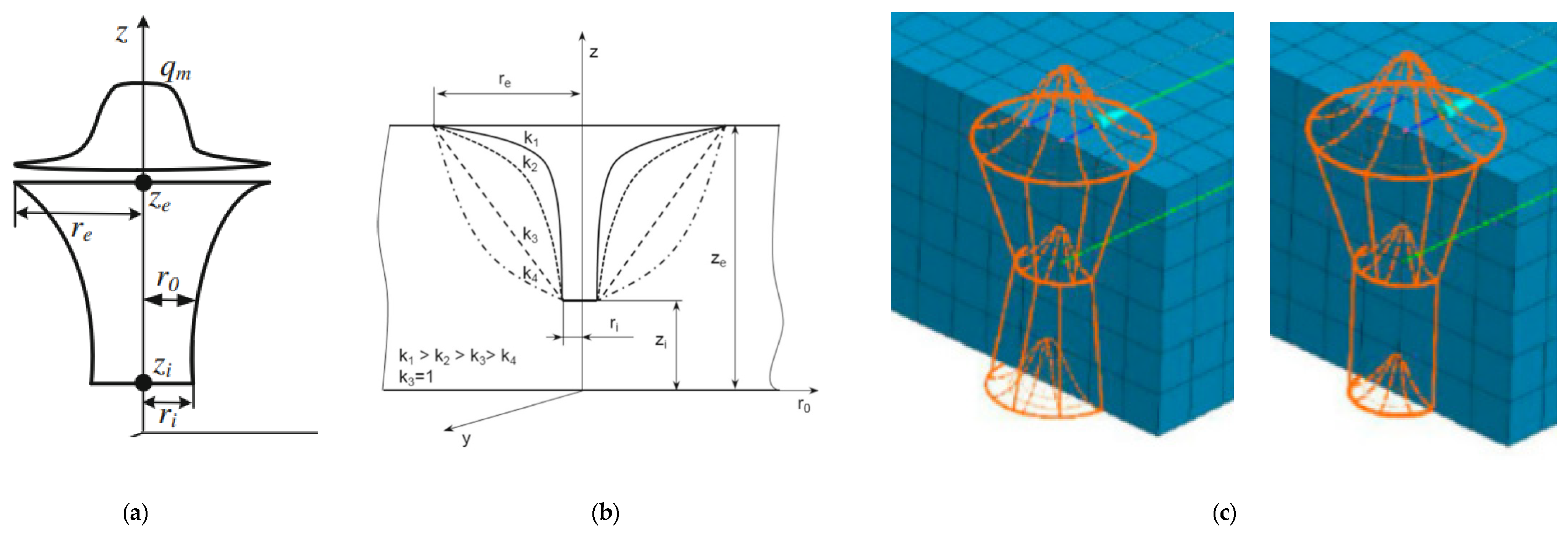
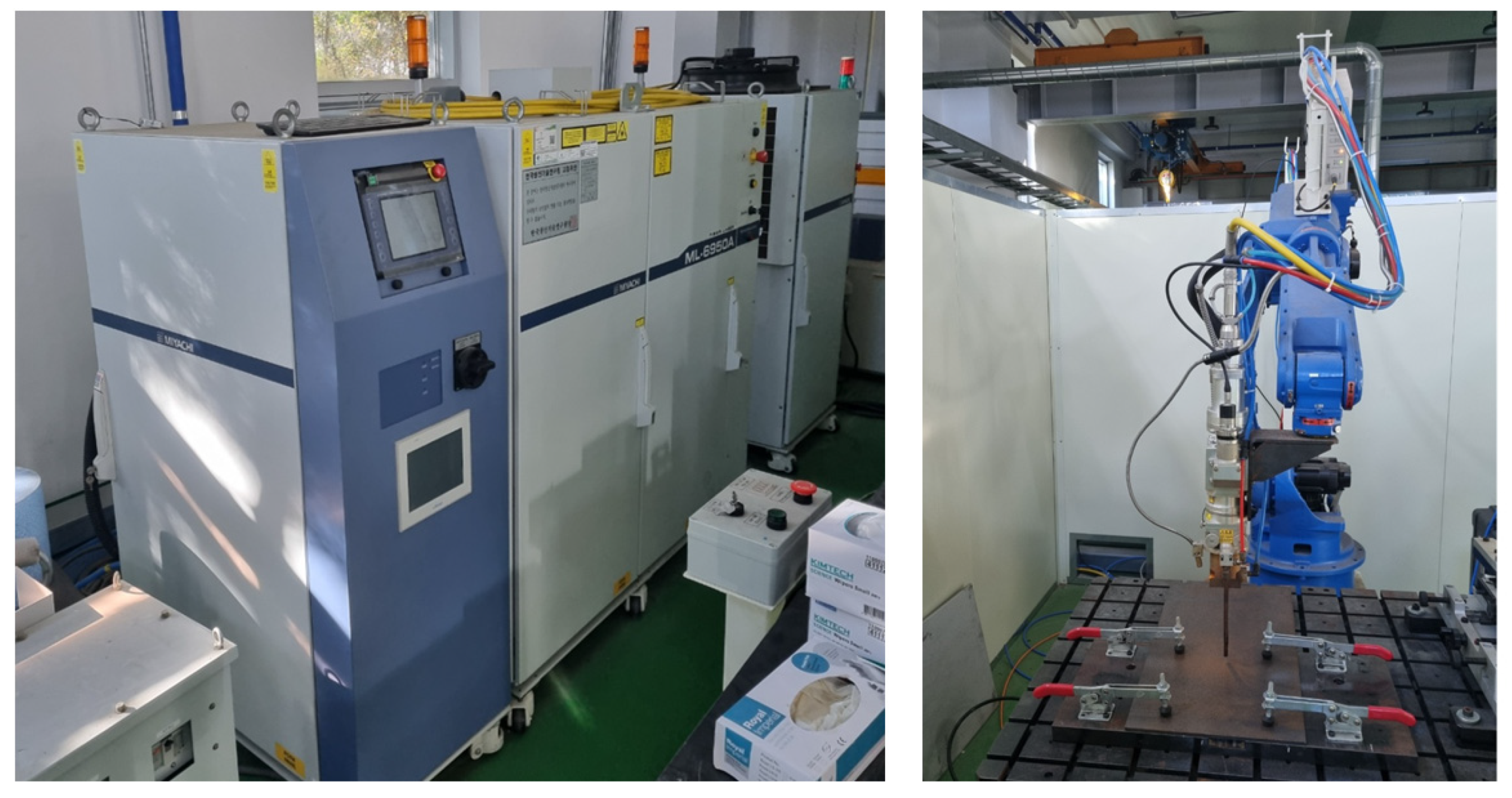

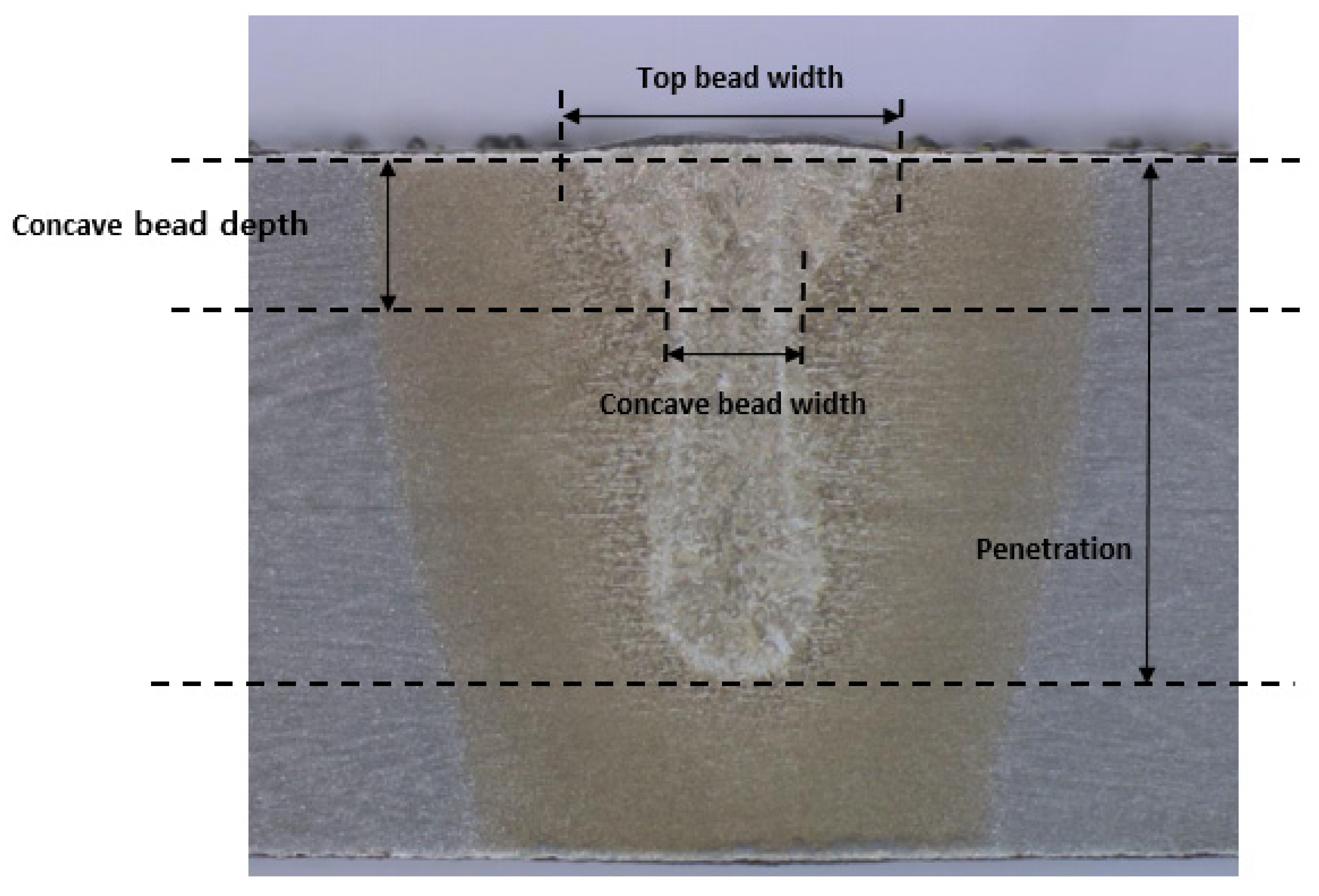
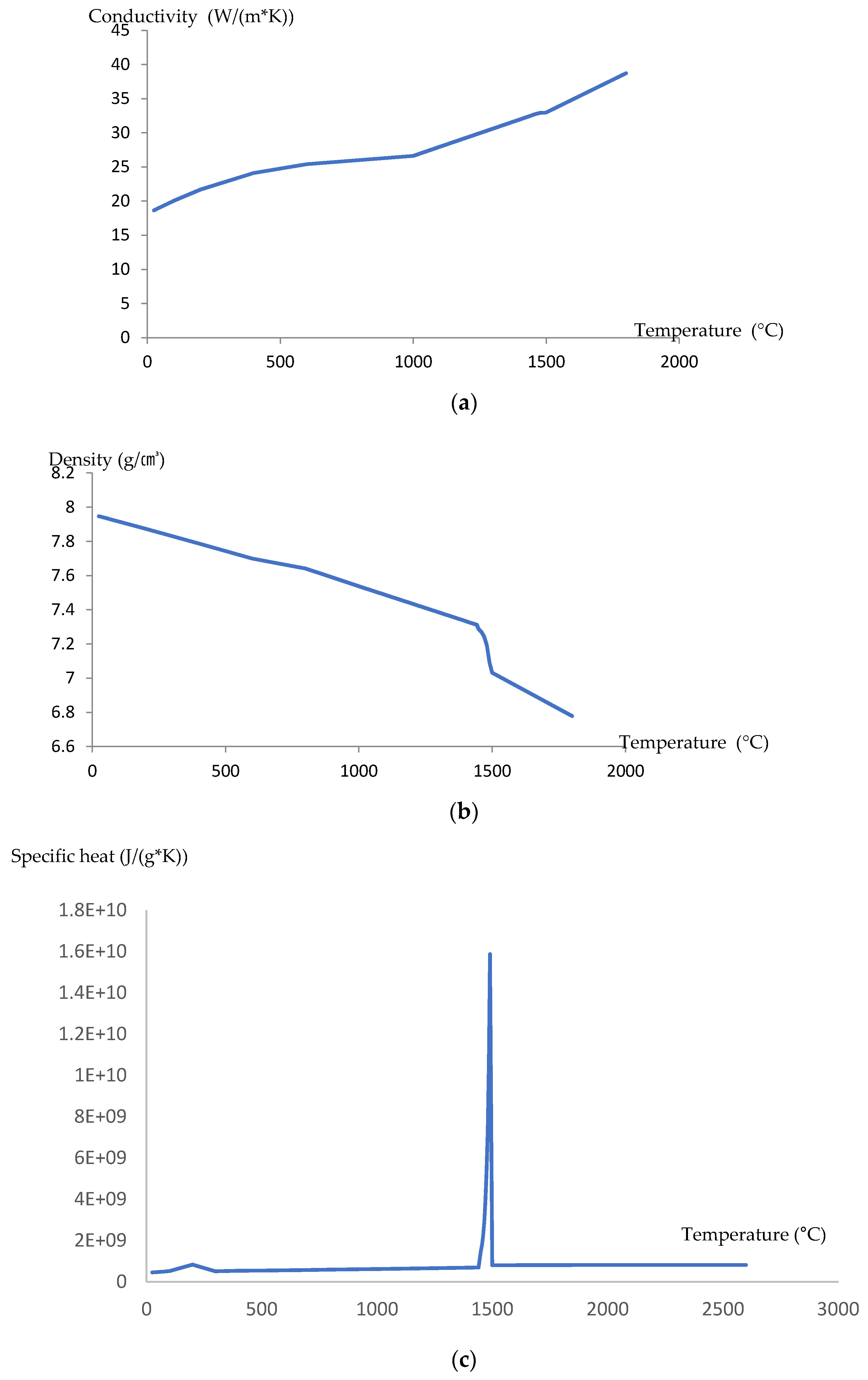
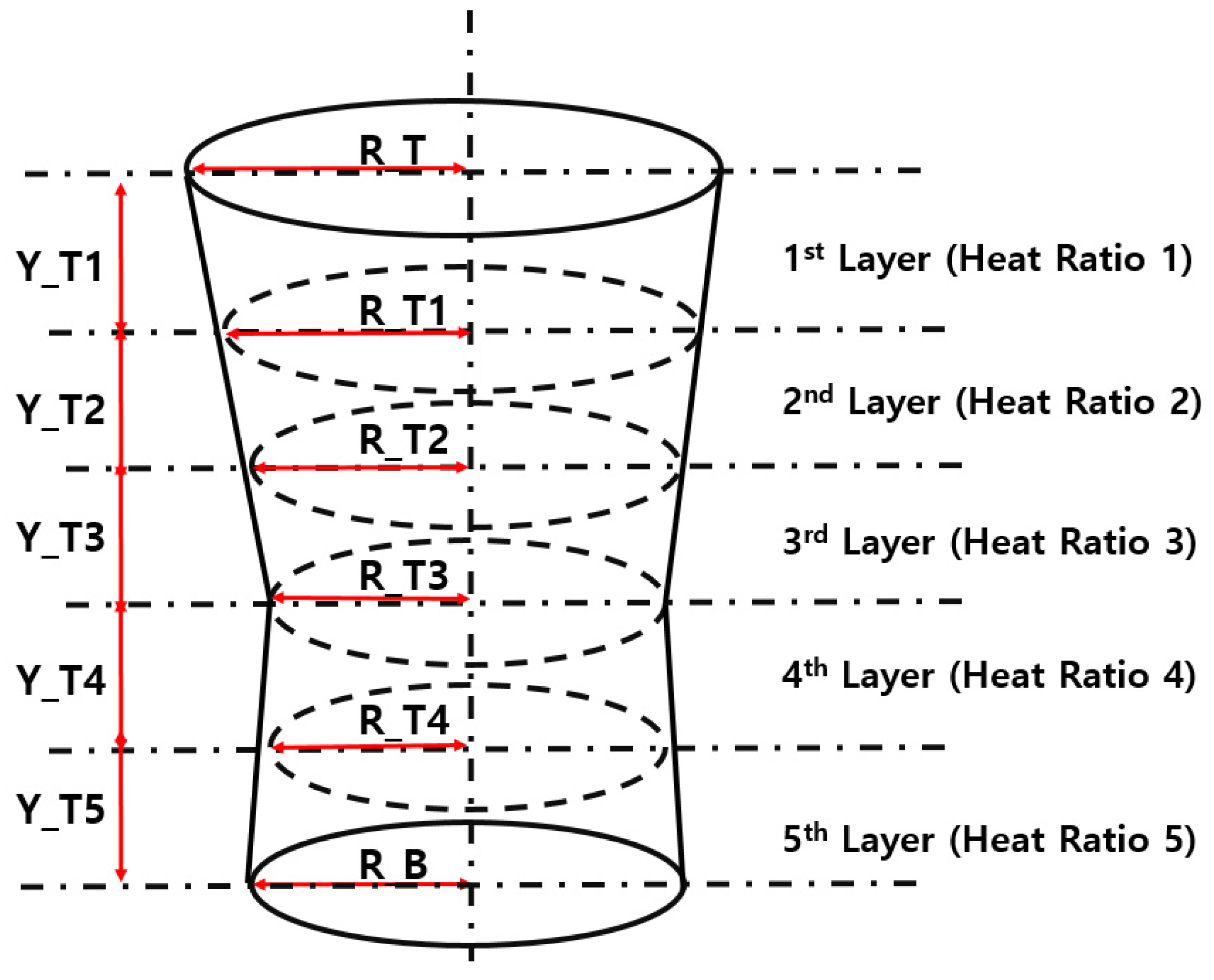


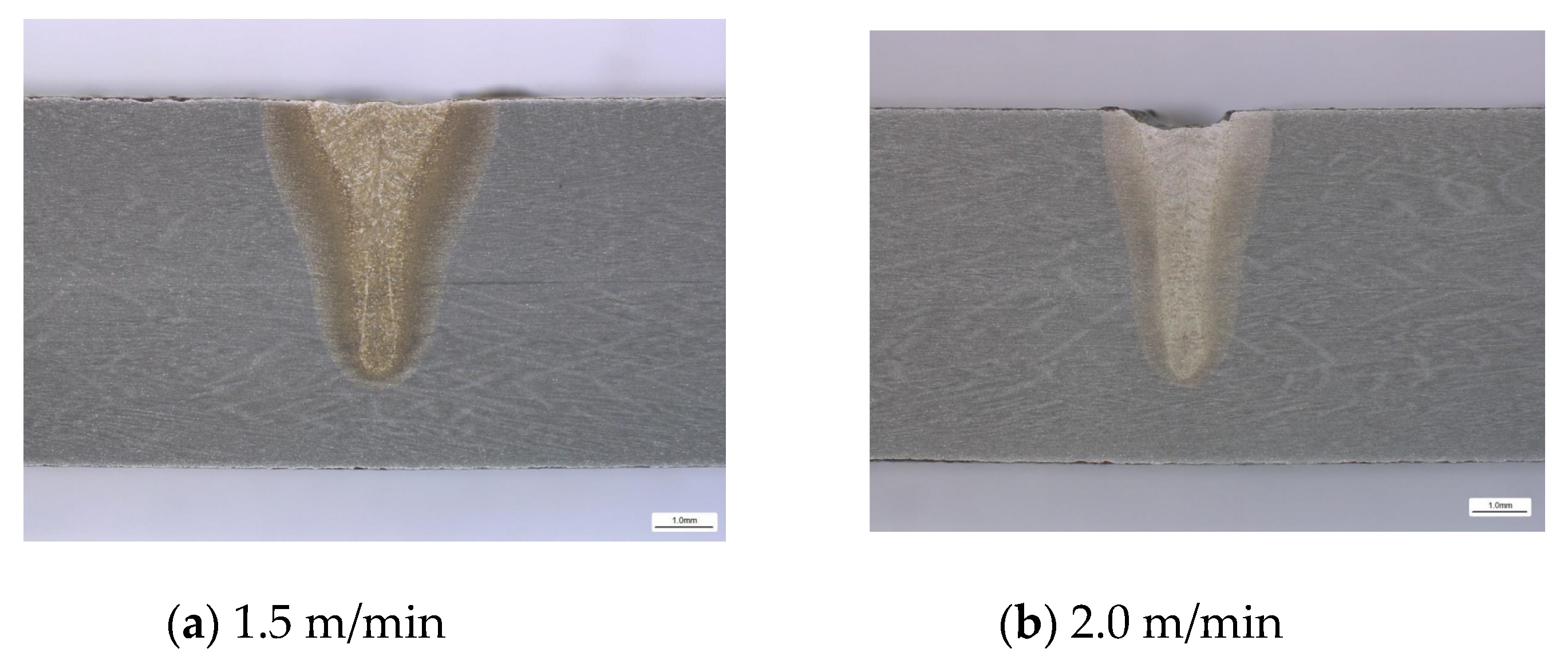

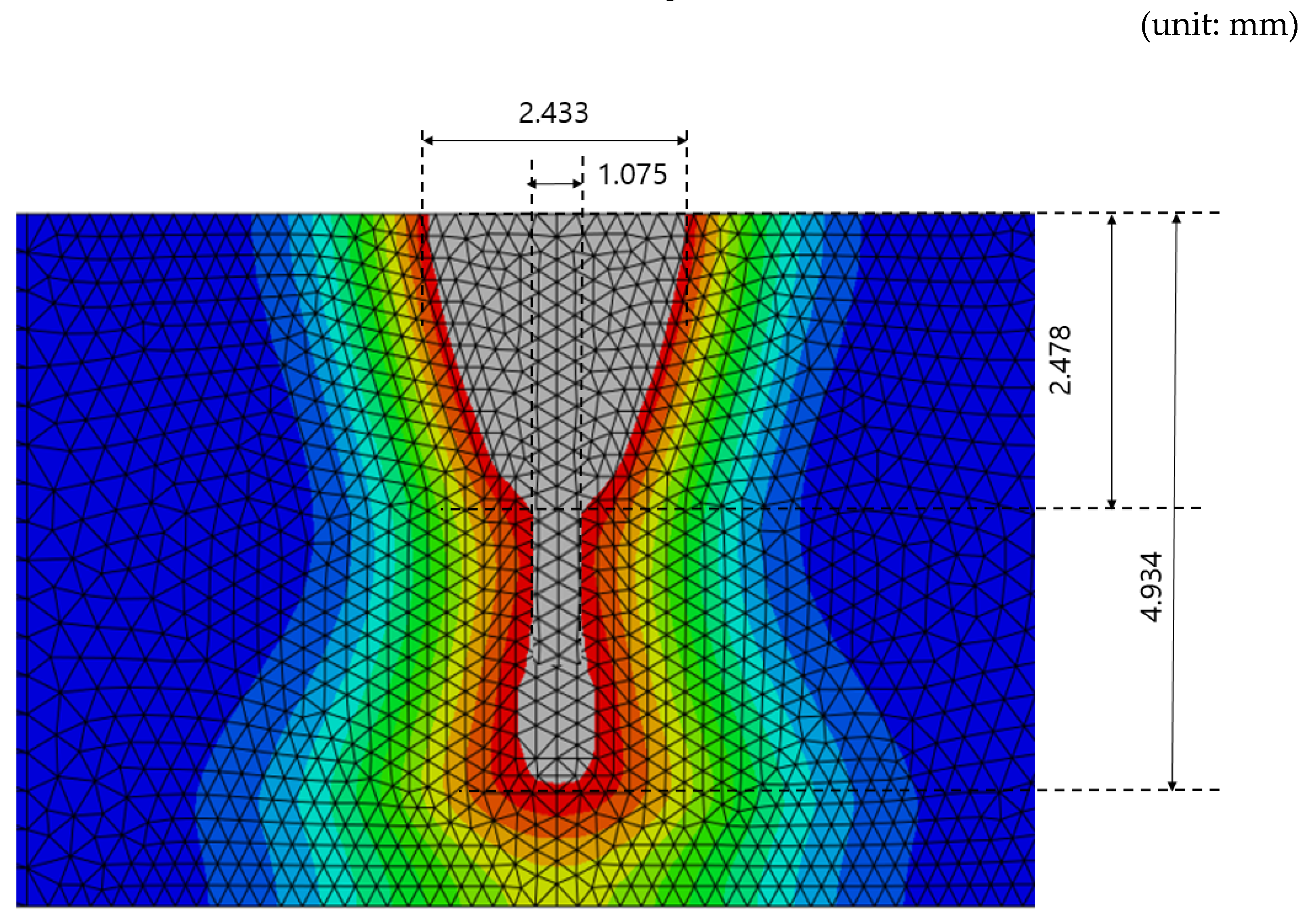
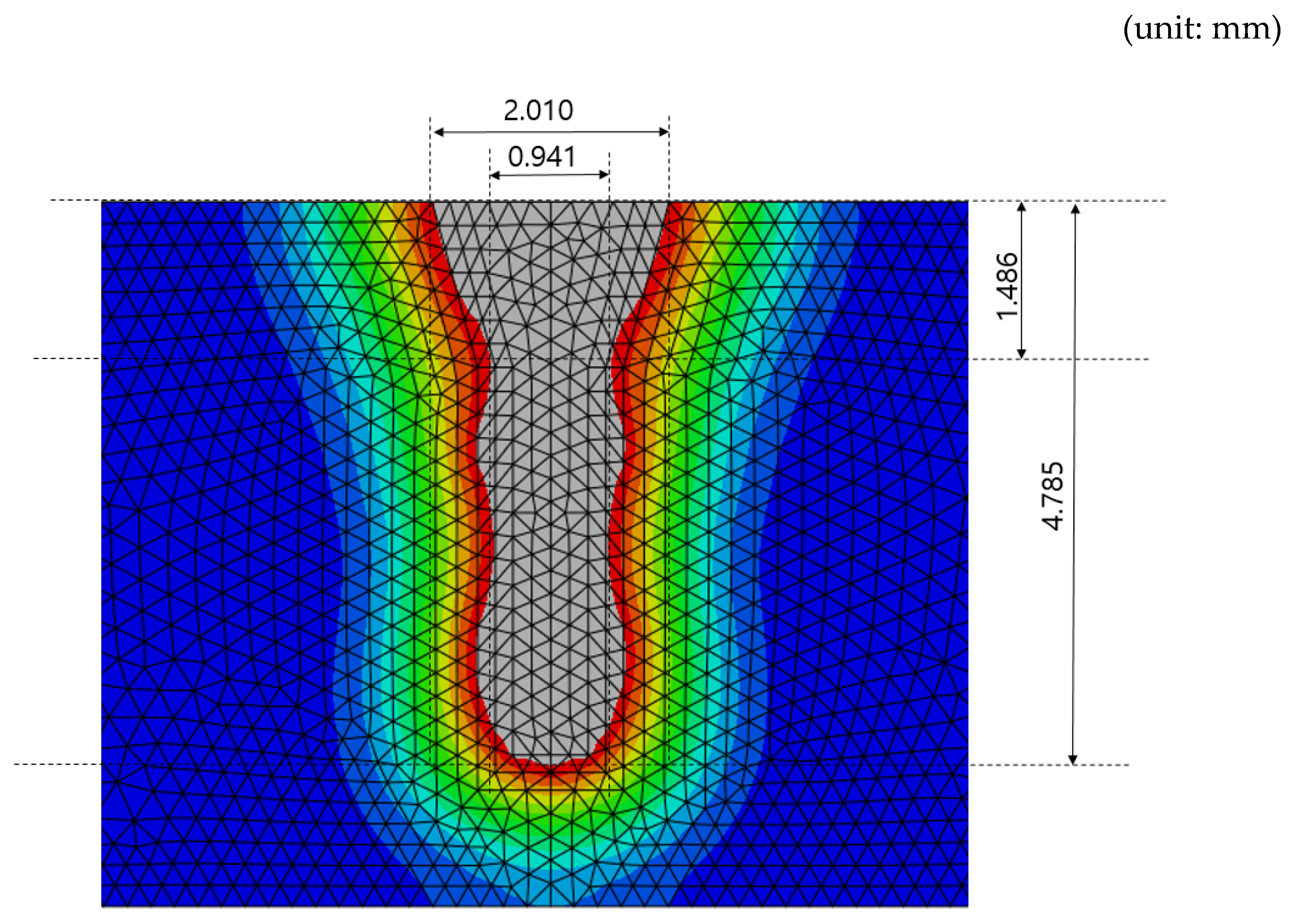

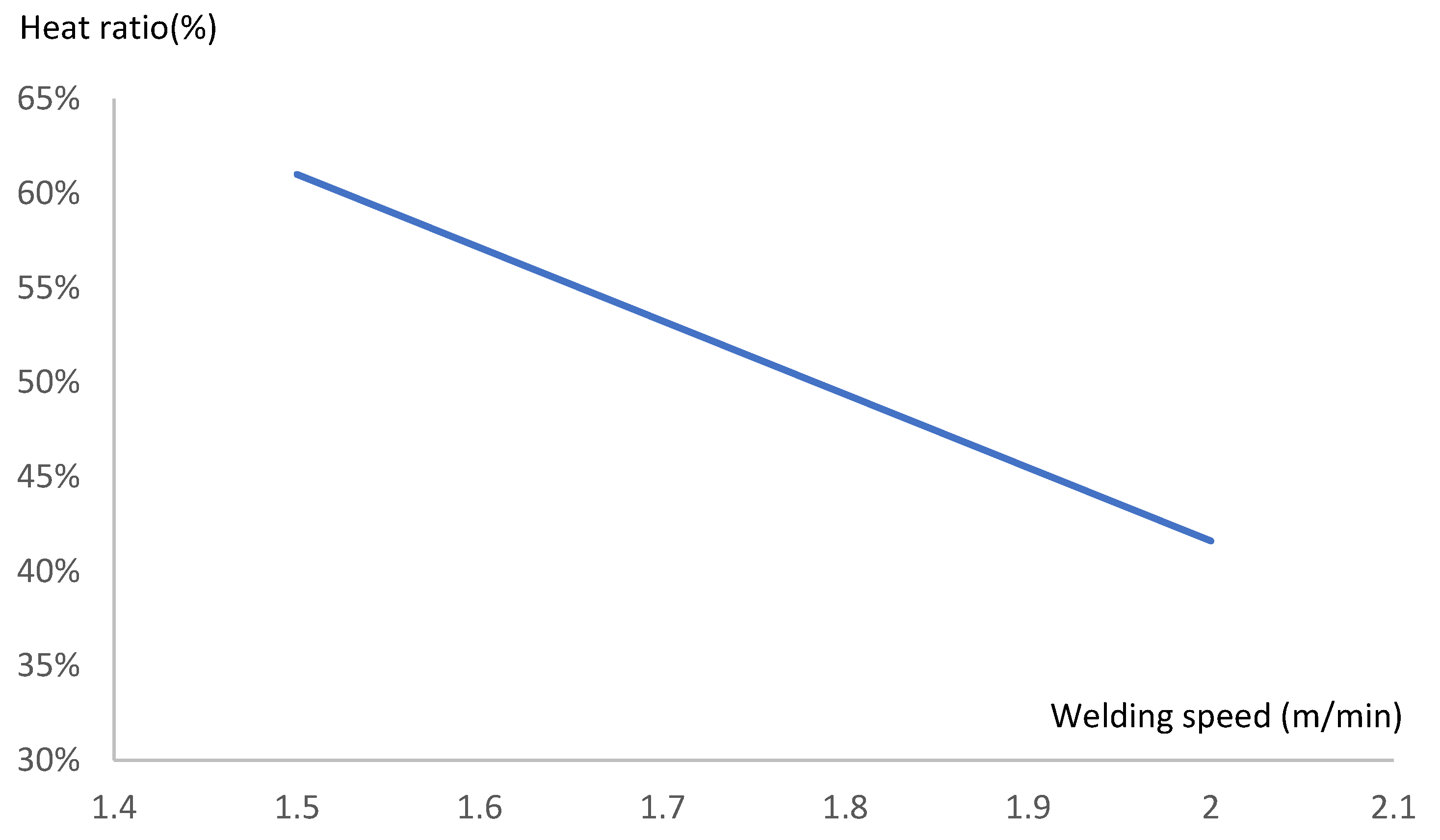
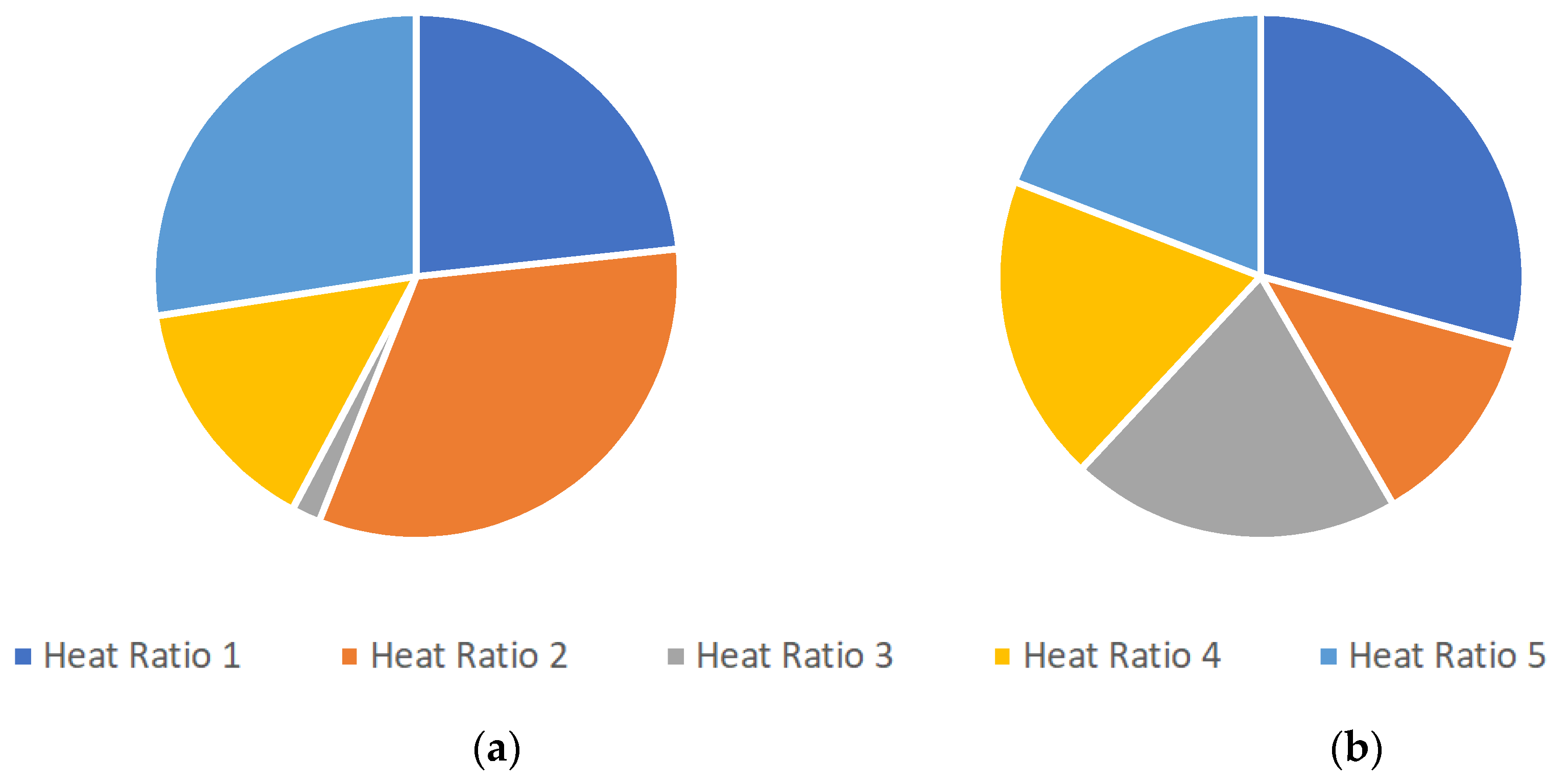
| Material | C | Si | Mn | S | P | Ni | Fe |
|---|---|---|---|---|---|---|---|
| A553-1 | 0.05 | 0.67 | 0.004 | 0.003 | 0.25 | 9.02 | Bal. |
| Variables | Meaning |
|---|---|
| Efficiency | Welding efficiency |
| RT | Top radius of 1st layer (top layer) |
| RT1 | Top radius of 2nd layer |
| RT2 | Top radius of 3rd layer |
| RT3 | Top radius of 4th layer |
| RT4 | Top radius of 5th layer |
| RB | Bottom radius of 5th layer |
| Heat Ratio 1 | Heat ratio of 1st layer |
| Heat Ratio 2 | Heat ratio of 2nd layer |
| Heat Ratio 3 | Heat ratio of 3rd layer |
| Heat Ratio 4 | Heat ratio of 4th layer |
| Heat Ratio 5 | Heat ratio of 5th layer |
| Heat depth | Length of heat source in depth direction |
| Welding Speed (m/min). | Top Bead Width (mm) | Concave Bead Width (mm) | Concave Bead Depth (mm) | Penetration (mm) |
|---|---|---|---|---|
| 1.5 | 2.583 | 1.075 | 2.275 | 4.867 |
| 2.0 | 1.717 | 0.941 | 1.410 | 4.860 |
| 1.5 Mpm | 2.0 Mpm | |
|---|---|---|
| EFFICIENCY | 0.884 | 0.873 |
| R_T | 2.164 | 2.110 |
| R_T1 | 0.446 | 1.454 |
| R_T2 | 0.357 | 1.075 |
| R_T3 | 0.781 | 0.371 |
| R_T4 | 0.861 | 0.869 |
| R_B | 4.010 | 1.184 |
| HEAT_depth | 5.242 | 4.885 |
| Heat Ratio 1 | 0.233 | 0.292 |
| Heat Ratio 2 | 0.327 | 0.124 |
| Heat Ratio 3 | 0.018 | 0.203 |
| Heat Ratio 4 | 0.148 | 0.189 |
| Heat Ratio 5 | 0.274 | 0.192 |
Publisher’s Note: MDPI stays neutral with regard to jurisdictional claims in published maps and institutional affiliations. |
© 2021 by the authors. Licensee MDPI, Basel, Switzerland. This article is an open access article distributed under the terms and conditions of the Creative Commons Attribution (CC BY) license (https://creativecommons.org/licenses/by/4.0/).
Share and Cite
Pyo, C.; Kim, J.; Kim, D.-S. A Study on Welding Deformation in Fiber Laser Welding of 9% Nickel Steel through Finite Element Analysis Part I: Implementation of Welding Heat Source Model. Processes 2021, 9, 2188. https://doi.org/10.3390/pr9122188
Pyo C, Kim J, Kim D-S. A Study on Welding Deformation in Fiber Laser Welding of 9% Nickel Steel through Finite Element Analysis Part I: Implementation of Welding Heat Source Model. Processes. 2021; 9(12):2188. https://doi.org/10.3390/pr9122188
Chicago/Turabian StylePyo, Changmin, Jaewoong Kim, and Du-Song Kim. 2021. "A Study on Welding Deformation in Fiber Laser Welding of 9% Nickel Steel through Finite Element Analysis Part I: Implementation of Welding Heat Source Model" Processes 9, no. 12: 2188. https://doi.org/10.3390/pr9122188
APA StylePyo, C., Kim, J., & Kim, D.-S. (2021). A Study on Welding Deformation in Fiber Laser Welding of 9% Nickel Steel through Finite Element Analysis Part I: Implementation of Welding Heat Source Model. Processes, 9(12), 2188. https://doi.org/10.3390/pr9122188






